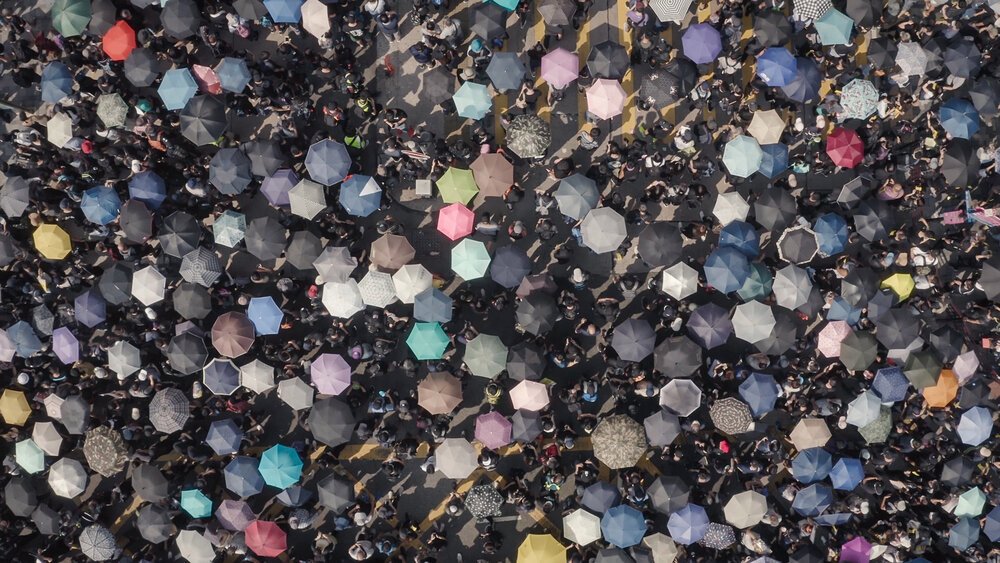ART NEWS
Ai Weiwei’s Latest Film Takes a Rousing Look at Hong Kong’s Protest Movement
In early 2020, as Covid-19 forced many countries to go into lockdown, some said it felt as though the world was ending. But for some, the world had already ended, and artist Ai Weiwei’s latest documentary, Cockroach, stands as proof of that sentiment. Its focus is the intense protests that rocked Hong Kong in 2019, when millions took to the streets to speak out against an extradition bill that would see the territory stripped of democracy. While Ai’s footage is from the not-so-distant past, it often feels like a missive from the post-apocalyptic future. Barricades burning, police firing into the crowd, masked protesters smashing glass around Estée Lauder and Lancôme stores—it all feels like the stuff of Blade Runner and Strange Days, and yet this all took place little more than a year ago.
Related Articles
Cockroach’s soundtrack, filled as it is with percussive banging and droning, only heightens the horror of the situation, and it is not the first time Ai has flirted with the genre. Earlier this year, the artist released Coronation, a documentary about the coronavirus pandemic’s beginnings in Wuhan, China, that explored the eerie ways life was turned upside down there. It envisions a version of China that seems like it could not possibly exist now—a hellish future that is, against all odds, the recent past.
Whereas Coronation was focused on individuals entangled in something much larger than them, Cockroach is about a mass movement. In an unusual gesture for a documentary, it has no discernible protagonists, and it rarely offers the sense of a linear timeline. Instead, the film offers a view of a movement too big to picture—a sprawling, decentralized mass action that is led by too many to count. One unidentified protester mentions that much of the organizing took place on social media and was done by the layperson. He calls the movement “a spiderweb of idea sharing.”
The specific factors that led to the protests’ beginnings are never explained to viewers, who are largely left to do that research on their own. There is only passing mention of a proposed 2019 bill that would potentially create extradition treaties between Hong Kong and mainland China, as well as Macau and Taiwan. Human rights groups claimed that the bill would severely delimit Hong Kongers’ democratic rights and potentially change the territory forever, and many international businesses, politicians, and journalists quickly raised concerns as well. In the end, the bill was tossed out, but other similar forms of legislature are still being considered by politicians, which in turn have continued to generate protests.
Still from Ai Weiwei’s Cockroach.
Courtesy Ai Weiwei Studio
For some in Ai’s film, these are hardly new struggles, however. “Well, let’s be clear,” says Emily Lau, a Hong Kong politician, in one interview. “We’ve never had democracy in China or Hong Kong.”
Early on, Ai offers a montage of images of protesters chanting their five demands: the withdrawal of the bill, a consideration of the protests as something other than a riot, amnesty for those arrested during the protests, an investigation into police brutality, and universal suffrage. It is clear that Ai and the talented team that worked with him to craft Cockroach empathize deeply with these demands and the people shouting them, and they have gone to great pains to humanize the protesters as something more than churlish dissidents. He features interviews with a number of people who never expected that they would get involved: a straight-A student, a young illustrator with a knack for social media, a largely apolitical bank worker who has grown fed up with Hong Kong’s leadership. In Ai’s portrayal of the movement, just about anyone could be involved. “If you are an artist, if you are a mother, if you are a musician, you can use your way to do it,” says Denise Ho, a Hong Kong pop star whose activism has helped galvanize many over the past couple years.
Throughout, there are numerous overhead shots of people convening in streets, their umbrellas—a reference to 2014’s Umbrella Movement, which began after China went back on a promise to offer Hong Kong open elections by 2017—forming a multicolor shield around them. And there are also memorable images of massive crowds taking over public spaces and claiming them as their own. In one standout shot, Ai’s camera offers a view of a mall’s atrium packed wall to wall with protesters, his camera traveling up an escalator as the action’s attendees ascend to the upper floors.
Still from Ai Weiwei’s Cockroach.
Courtesy Ai Weiwei Studio
Alongside this, there are reminders that life continued on largely as usual all the while. People continued to sip bubble tea at cafes, and some in Hong Kong’s swankiest business districts reported to work as usual. That footage stands as proof that, while the mass pandemonium may have touched a large part of Hong Kong’s population, some considered themselves insulated from the violence that took place in the streets every day.
Yet the sequences that leave the greatest mark include footage of altercations between protesters and police officers, especially the ones that took place at Hong Kong Polytechnic University, in one of the bloodiest standoffs of the movement. Ai portrays these protests as all-out war, with activists tossing Molotov cocktails at officers, and the artist’s cinematographers have clearly put themselves in the thick of the action, dodging rubber bullets and tear gas canisters amid the chaos. Sometimes, there is enough of a lull for the crew to capture horrifying images of sprays of blood lining the streets following the violent arrests of those who attended.
The frequent shots of violence throughout the film are reminders that what Ai is showing us is very much real—a fact that is often hard to believe, even for the protesters involved. At one point, one masked activist says, “It’s like being in a movie.”
Cockroach is now streaming on Vimeo.











